A Coruna's trams
Many of Europe's major cities now have some form of tram system to help move people around and most are ugly and inefficient. The one at A Coruna is however somewhat different as the photographs will testify.
A Coruna's trams come in different colours which I believe are red, white, yellow, blue and
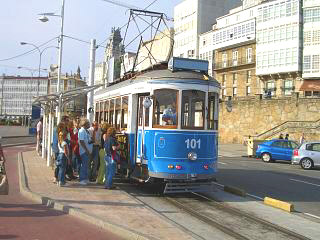 green. At a first glance the trams appear to date back to the turn of the twentieth century and look very reminiscent of those found in Britain at that time. On getting on to one of these trams, the clean and fresh interior appears to set the record straight and suggest that they are in fact modern replicas of older models – at least that is what I thought. Above right, the blue tram that we rode on.
green. At a first glance the trams appear to date back to the turn of the twentieth century and look very reminiscent of those found in Britain at that time. On getting on to one of these trams, the clean and fresh interior appears to set the record straight and suggest that they are in fact modern replicas of older models – at least that is what I thought. Above right, the blue tram that we rode on.
The tram system runs from the "sea front" center of the "Puerto de a Coruna" encircling the headland and round to the middle of the "Ensenada del Orzan". On route it makes several stops including those at the "Tower of Hercules" lighthouse, the "Domus" museum and the "castle of St. Anton". The cost of travelling the full (one way) journey was one euro per person – you pay twice if you want to go there and back.
When we took the tram is was a hot August day and the breeze that came through the open
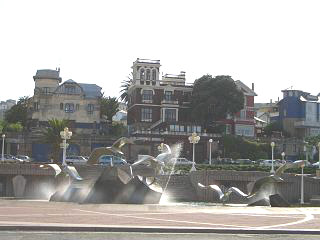 windows was reward enough. That said, the route is highly scenic and, aside from giving you easy access from one bay to the next, also offers some great views of the coastline, the town and some of its monuments and beaches.
windows was reward enough. That said, the route is highly scenic and, aside from giving you easy access from one bay to the next, also offers some great views of the coastline, the town and some of its monuments and beaches.
Among the many sights passed by on the tram was an ornimental landscaped fountain which you can see in the photo to the left, but the entire journey offered great views out to sea.
Finally, back to the trams themselves. They get their power from overhead electricity cables supported on red curvy aesthetic iron poles and each tram can travel in both directions without
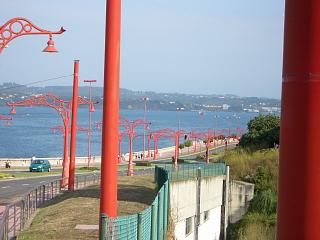 turning around. It sounds simple, but it is actually quite ingenious. At the end of each journey the driver "evicts" the passengers and then pushes each of the bench seat's back rests against the direction of imminent travel. The double sided backrests rotate from one end of the seat to the other resulting in the "facing direction" of each seat being reversed. The driver then engages the controls at the opposite end of the tram and the job is done. The whole process takes about two minutes.
turning around. It sounds simple, but it is actually quite ingenious. At the end of each journey the driver "evicts" the passengers and then pushes each of the bench seat's back rests against the direction of imminent travel. The double sided backrests rotate from one end of the seat to the other resulting in the "facing direction" of each seat being reversed. The driver then engages the controls at the opposite end of the tram and the job is done. The whole process takes about two minutes.
So what about the origin and history of the trams themselves!
When we were finally ready to exit we approached the driver and asked where the trams were
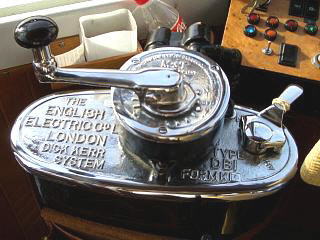 made and how old they were? The driver simply pointed towards the small highly polished dashboard console. Our tram, the blue one in the photos, was made by the "English Electric Co. Ltd, London" just after the turn of the twentieth century and was now approaching one hundred years old. I doubt that there will be a single example of one of these trams anywhere in the UK – thank God for the foresight of someone in A Coruna.
made and how old they were? The driver simply pointed towards the small highly polished dashboard console. Our tram, the blue one in the photos, was made by the "English Electric Co. Ltd, London" just after the turn of the twentieth century and was now approaching one hundred years old. I doubt that there will be a single example of one of these trams anywhere in the UK – thank God for the foresight of someone in A Coruna.
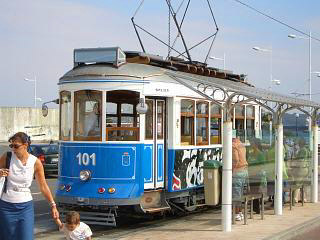
To find out about another "British – A Coruna" connection, follow this link to our page about Scottish military leader Sir John Moore. Hardly mentioned in British history, he is a hero in A Coruna and Galicia.
Right, one last shot of the tram.
Back to the A Coruna general page.

